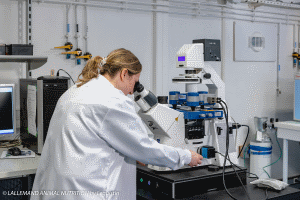19 November 2019- September 2019 marked four years since Lallemand Animal Nutrition launched YANG (Yeast Association New Generation) at SPACE in France, and February 2020 will mark the product's fourth year on the European market.
YANG, a product made from several specific and complementary strains of inactivated yeast, was described by Lallemand Animal Nutrition as the first yeast derivative of its kind. With the power to support animals’ natural defenses, YANG came from several years’ of research of yeast cell surface properties to find those strains which could best maintain proper gut flora and modulate the immune system response by activating multiple immune receptors.
However, Lallemand has certainly not spent the last four years coasting on that success. As was made clear in a conversation with Bruno Bertaud, Technical Manager for Yeast Derivatives and Antioxidants, the company has remained hard at work expanding on YANG’s benefits in a greater number of species and studying how the product can make a difference in production systems with constraints such as low antibiotic use or ZnO-free. Lallemand is keen to be recognized not only for a product that was, it argues, outstanding in its category to begin with, but also for a solution whose range of applications makes it useful for an ever greater variety of challenges.
|
[Feedinfo News Service] The last few years have seen significant work in expanding the application of YANG to a greater number of species, from piglets to pets, and broilers to aqua species. Can you take us through some of the most important recent research? |
|
[Feedinfo News Service] At the same time, the worldwide context for eubiotic feed additives has changed dramatically, with many jurisdictions further restricting the use of antibiotics and Europe moving to restrict the use of products such as ZnO and copper. Has YANG been successful in presenting itself as an innovative nutritional solution in, say, weaning piglets or antibiotic-free shrimp? How has the concept been received by the market?
[Bruno Bertaud] Indeed, we have performed studies showing how YANG is able to optimize growth and FCR of piglets in a context of Zinc Oxyde (ZnO) reduction in the starter phase. It was also demonstrated that, with YANG, it is possible to reduce ZnO in prestarer phase while maintaining top growth performance. These results were presented in June at the Zero Zinc Summit in Copenhagen, reinforcing the credibility of this approach among experts. The benefit of using of YANG in such context has been well understood by the market: in Europe for piglets or young ruminants; and in Asia in shrimp farming, in situations where the reduction of use of antibiotics is a key target.
[Feedinfo News Service] Lallemand Animal Nutrition has asserted that YANG was the first yeast derivative on the market consisting of an association of different yeast fractions. Is that still the case, or have other “YANG-like products” come on the market since YANG’s launch?
[Bruno Bertaud] In 2015, YANG was the first association of yeast derivatives on the market formulated from selected yeast strains. Whereas yeast products like yeast cell walls had been used previously, Lallemand Animal Nutrition went into uncharted territory with YANG, using cutting-edge techniques to examine the cell surface and select strains with optimal binding capacities. Today, YANG remains the only yeast derivative product issued from a specific strain screening process and with such a high level of yeast cell characterization. This is still unique on the market and I can say that even though YANG is 4 years old now, it still remains really innovative.
[Feedinfo News Service] What have been the important insights on the mechanistic front which have allowed YANG to succeed? Has this been an important part of keeping competing products at bay?
[Bruno Bertaud] As we have been documenting the in vivo effects of YANG, we have continued to look into its mode of action. One of the significant findings—and this is unique in the field of yeast derivatives—is the interaction of each yeast fraction of the product with the immune cells of the host.
Remember that one of the properties of yeast cell walls is the interaction with immune receptors in the gut. It is known that β-glucans recognize a certain type of receptors called Dectin-1 at the surface of immune cells. We have shown that the combination of the yeast fractions present in YANG is able to stimulate not only this Dectin-1, but also other receptors. We have now identified these receptors (MBR and Toll-like receptors). This multi-receptors modulation allows a balanced immune response and explains the synergy between the yeast fractions on the immune system. To my knowledge, such level of specification has not been demonstrated for other products (we have even filed a patent to document this).
The other power of yeast derivatives is the ability to bind and agglutinate undesirable bacteria. Here too, yeast fractions in YANG were selected for their optimal binding capacity. A recent in vitro study performed in an independent research institute in Italy confirms that YANG aggregates E. coli pathogens present in dogs’ and cats’ guts.
[Feedinfo News Service] Do you imagine you might eventually broaden the YANG portfolio to include different “formulas” or “recipes” of yeast derivatives for different production goals? Or do you expect to remain with these particular strains and fractions for the foreseeable future?
|
Lallemand researcher Marion Schiavone employing Atomic Force Microscopy |
[Bruno Bertaud] We formulated YANG after screening hundreds of yeast strains to identify the best ones based on advanced technologies. It allowed us to have the best effect in terms of undesirable bacteria binding and immune system modulation. The formula today is optimal, with a wide spectrum of actions, and we are convinced we are still at the beginning of the story. We are therefore not looking for other strains or a new formula for YANG but we continue to explore other functionalities and potential promising applications (e.g. benefits in case of coccidiosis challenge in broilers). |
Published in association with Lallemand Animal Nutrition





